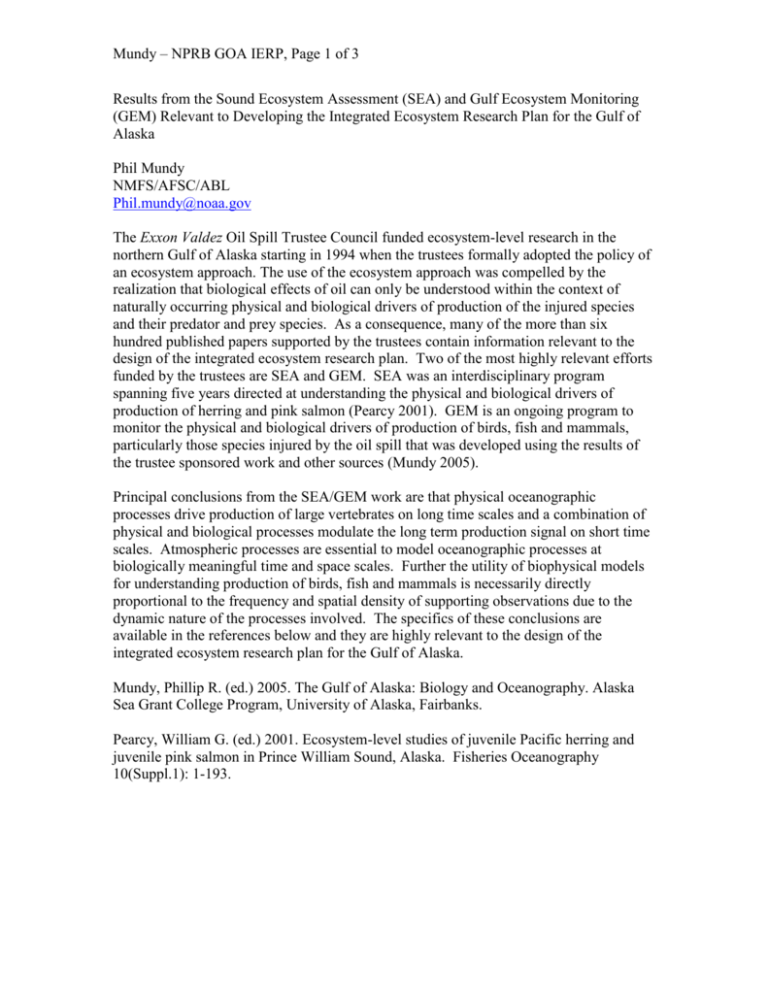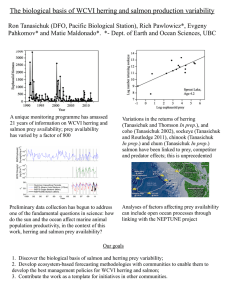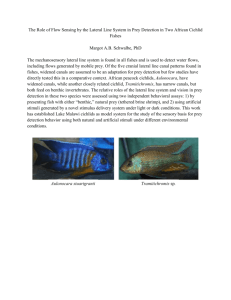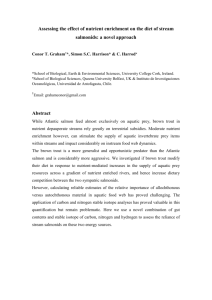Mundy GOA Essentials forthe NPRB IERP
advertisement

Mundy – NPRB GOA IERP, Page 1 of 3 Results from the Sound Ecosystem Assessment (SEA) and Gulf Ecosystem Monitoring (GEM) Relevant to Developing the Integrated Ecosystem Research Plan for the Gulf of Alaska Phil Mundy NMFS/AFSC/ABL Phil.mundy@noaa.gov The Exxon Valdez Oil Spill Trustee Council funded ecosystem-level research in the northern Gulf of Alaska starting in 1994 when the trustees formally adopted the policy of an ecosystem approach. The use of the ecosystem approach was compelled by the realization that biological effects of oil can only be understood within the context of naturally occurring physical and biological drivers of production of the injured species and their predator and prey species. As a consequence, many of the more than six hundred published papers supported by the trustees contain information relevant to the design of the integrated ecosystem research plan. Two of the most highly relevant efforts funded by the trustees are SEA and GEM. SEA was an interdisciplinary program spanning five years directed at understanding the physical and biological drivers of production of herring and pink salmon (Pearcy 2001). GEM is an ongoing program to monitor the physical and biological drivers of production of birds, fish and mammals, particularly those species injured by the oil spill that was developed using the results of the trustee sponsored work and other sources (Mundy 2005). Principal conclusions from the SEA/GEM work are that physical oceanographic processes drive production of large vertebrates on long time scales and a combination of physical and biological processes modulate the long term production signal on short time scales. Atmospheric processes are essential to model oceanographic processes at biologically meaningful time and space scales. Further the utility of biophysical models for understanding production of birds, fish and mammals is necessarily directly proportional to the frequency and spatial density of supporting observations due to the dynamic nature of the processes involved. The specifics of these conclusions are available in the references below and they are highly relevant to the design of the integrated ecosystem research plan for the Gulf of Alaska. Mundy, Phillip R. (ed.) 2005. The Gulf of Alaska: Biology and Oceanography. Alaska Sea Grant College Program, University of Alaska, Fairbanks. Pearcy, William G. (ed.) 2001. Ecosystem-level studies of juvenile Pacific herring and juvenile pink salmon in Prince William Sound, Alaska. Fisheries Oceanography 10(Suppl.1): 1-193. Mundy – NPRB GOA IERP, Page 2 of 3 GEM and SEA/APEX: Control of production of birds, fish and mammals in the Gulf of Alaska Determinants of birth, growth and death Classical dichotomy 1. Fishing, predation, disease and associated interactions with physical controls 2. Physical control of rates of production, distribution of production and pathways of energy flow (species composition) SEA specifics Year class strength in pink salmon is primarily determined in the first 180 days after marine entry by mortalities that are dependent on prey density, species composition of prey, and the joint spatial distributions of juvenile pink salmon, predators and prey, and the interactions among these factors. o Prey density: Prey density determines growth rate which in turn determines rate of predation on salmon o Prey density: Prey density is determined by atmospheric and oceanic forcing through physical transport of prey and delivery of nutrients to the first trophic level. o Species composition: The presence and availability of large copepods determines distribution of pink salmon and their predators more so than the presence and availability of other species of zooplankton. o Species composition: The presence and availability of large copepods determines the rate of predation on juvenile pink salmon o Spatial distribution: Rates of salmon mortality are lower when salmon are near shore and conversely o Species composition: Rates of salmon mortality are modulated by species composition of prey independent of joint distributions of pink salmon and prey; more large copepods mean lower predation rates on salmon o Interactions between spatial distribution and species composition are important determinants of year class strength in pink salmon o Interactions between prey density and species composition are important determinants of year class strength in pink salmon o Interactions between temperature and growth are important determinants of year class strength in pink salmon Year class strength in herring is primarily determined in the first 180 days after hatching by mortalities that are dependent on prey density, species composition of prey, the spatial distribution juvenile herring in the fall of the first year of life. o Prey density: Prey density in summer determines the allocation of energy between storage and bodily structure. Mundy – NPRB GOA IERP, Page 3 of 3 o Prey density: Prey density in summer controls winter survival by determining energy reserves of age-0 herring in the fall. o Prey density: Prey density is determined by atmospheric and oceanic forcing through physical transport of prey and delivery of nutrients to the first trophic level. o Spatial distribution: Mortality is controlled by transport of larvae to suitable rearing habitat (embayments) o Species composition: Species composition of prey determines energy density which determines size at age and energy content of herring in the fall o Interactions between spatial distribution and species composition are important determinants of year class strength in herring o Interactions between prey density and species composition are important determinants of year class strength in herring o Interactions between temperature and growth are important determinants of year class strength in herring








